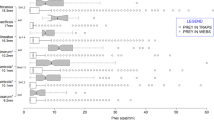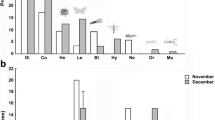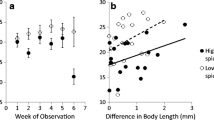Summary
Colonial orb-weaving spiders from Mexico were studied to test predictions of risksensitive foraging theory: 1. group foraging increases prey capture/individual, and reduces prey variance; 2. spiders should be expected to exhibit risk-averse behavior (forage in groups) when the average level of prey exceeds individual needs, and exhibit risk-prone behavior (forage solitarily) when prey are searce. Laboratory and field studies show that group foraging increases capture efficiency and reduces variability in prey captured per spider. In desert/mesquite grassland habitat, where prey availability is low, M. atascadero forage solitarily in most cases. In tropical rainforest/agriculture sites, M. increassata forage in large colonies of thousands of webs. In intermediate habitats, M. spinipes forages solitarily or in groups, depending on prey availability. Over a range of sites with varying levels of prey, M. spinipes shifts from a risk-prone to a risk-averse group foraging strategy as prey increases.
Group foraging behavior observed in colonial Metepeira fits the predictions of risk-sensitive foraging models. These findings explain why spiders tend to group webs together only in areas of superabundant prey. The role of risk-sensitivity in the evolution of coloniality in spiders is discussed.
Similar content being viewed by others
References
Burgess JW (1978) Social behavior in group-living spider species. Symp Zool Soc London 42:69–78
Burgess JW, Uetz GW (1982) Social spacing strategies in spiders. In: Witt PN, Rovner JS (eds) Spider communication, mechanisms and ecological significance. Princeton Univ Press, Princeton, 440 pp
Buskirk RE (1975) Coloniality, activity patterns and feeding in a tropical orb-weaving spider. Ecology 56:1314–1328
Buskirk RE (1981) Sociality in the Arachnida. In: Hermann HR (ed) Social insects, Vol II. Academic Press, New York, pp 491
Cangialosi KR, Uetz GW (1987) Spacing in colonial spiders: effects of environment and experience. Ethology 76:236–246
Caraco T, Gillespie RG (1986) Risk-sensitivity: foraging mode in an ambush predator. Ecology 67:1180–1185
Caraco T, Pulliam HR (1984) Sociality and survivorship in animals exposed to predation. In: Price PW, Slobodchikoff CN, Gand WS (eds) A new ecology: novel approaches to interactive systems, pp 279–309. Wiley, New York
Crook J (1965) The adaptive significance of avian social organizations. Symp Zool Soc Lond 14:181–218
Gillespie RG (1981) The quest for prey by the web building spider Amaurobius similis (Blackwell). Anim Behav 29:953–954
Gillespie RG (1987) The role of prey availability in aggregative behavior in the orb weaving spider Tetragnatha elongata. Anim Behav 35:675–681
Honjo S (1977) Social behavior in Dictyna follicola (Araneae: Dictynidae). Acta Arachnol 27:213–219
Lubin YD (1974) Adaptive advantages and the evolution of colony formation in Cyrtophora (Araneae: Araneidae). Zool J Linn Soc 54:321–339
Morse DH, Fritz RS (1982) Experimental and observational studies of patch choice at different scales by the crab spider Misumena vatia. Ecology 63:172–182
Pulliam HR, Caraco T (1984) Living in groups: Is there an optimal group size? In: Krebs JR, Davies NB (eds) Behavioural ecology: an evolutionary approach. Sinauer, Sunderland, Mass, pp 122–147
Pulliam HR, Millikan GC (1982) Social organization in the non-reproductive season. In: Farner DS, King JR (ess) Avian biology Vol. 6, pp 45–87. Academic Press, New York
Real L, Caraco T (1986) Risk and foraging in stochastic environments. Ann Rev Ecol Syst 17:371–390
Riechert SE (1978) Energy-based territoriality in populations of the desert spider, Agelenopsis aperta (Gertsch). Symp Zool Soc London 42:211–222
Riechert SE (1981) The consequences of being territorial: spiders, a case study. Am Nat 117:871–892
Riechert SE, Gillespie RG (1986) Habitat choice and utilization in web-builing spiders. In: Shear WA (ed) Spiders: webs behavior, and evolution. Stanford Univ Press, Stanford, Calif, pp 23–48
Riechert SE, Roeloffs R, Echternacht AC (1986) The ecology of the cooperative spider Agelena consociata in equatorial Africa (Araneae, Agelenidae). J Arachnol 14:175–192
Riechert SE, Tracy CR (1975) Thermal balance and prey availability: bases for a model relating web-site characteristic to spider reproductive success. Ecology 56:265–284
Rypstra AL (1979) Foraging flocks of spiders — a study of aggregate behavior in Crytophora citricola Forskal (Araneae: Araneidae) in West Africa. Behav Ecol Sociobiol 5:291–300
Rypstra AL (1983) The importance of food and space in limiting web-spider densities; a test using field enclosures. Oecologia (Berlin) 59:312–316
Rypstra AL (1985) Aggregations of Nephila clavipes (L.) (Araneae, Araneidae) relation to prey availability. J Arach 13:71–78
Rypstra AL (1986) High prey abundance and a reduction in cannibalism: The first step to sociality in spiders (Arachnida). J Arachnol 14:193–200
Rypstra AL (1988) Foraging success of solitary and aggregated spiders: insights into-flock formation. Anim Behav (in press)
Shear WA (1970) The evolution of social phenomena in spiders. Brit Arachnol Soc 1:65–76
Thompson WA, Vertinsky J, Krebs JR (1974) The survival value of flocking in birds: A simulation model. J Anim Ecol 43:785–820
Tietjen WJ (1986) Social spider webs, with special reference to the webs of Mallos gregalis. In: Shear WA (ed) Spiders: webs, behavior, and evolution. Stanford Univ Press, Stanford, Calif, pp 172–206
Turnbull AL (1964) The search for prey by a web-building spider Achaearanea tepidariorum (C.L. Koch) (Araneae, Theridiidae). Can Entom 96:568–579
Uetz GW (1985) Ecology and behavior of Metepeira spinipes (Araneae: Araneidae), a colonial web-building spider from Mexico. Nat Geogr Res Rep 19:597–609
Uetz GW (1986) Web-building and prey capture in communal orb weavers. In: Shear WA (ed) Spiders: webs, behavior, and evolution. Stanford Univ Press, Stanford, Calif, pp 207–231
Uetz GW (1988) Risk-sensitivity and foraging in colonial spiders. In: Slobodchikoff CN (ed) Ecology of social behavior. Academic Press, New York
Uetz GW, Burgess JW (1979) Habitat structure and colonial behavior in Metepeira spinipes (Araneae: Araneidae), an orb weaving spider from Mexico. Psyche 86:79–89
Uetz GW, Cangialosi KR (1986) Genetic differences, in social behavior and spacing in populations of Metepeira spinipes Pickard-Cambridge (Araneae: Araneidae), a communal-territorial orb weaver. J Arachnol 14:159–174
Uetz GW, Kane TC, Stratton GE (1982) Variation in the social grouping tendency of a communal web-building spider. Science 217:547–549
Author information
Authors and Affiliations
Rights and permissions
About this article
Cite this article
Uetz, G.W. Group forating in colonial web-building spiders. Behav Ecol Sociobiol 22, 265–270 (1988). https://doi.org/10.1007/BF00299841
Received:
Accepted:
Issue Date:
DOI: https://doi.org/10.1007/BF00299841




